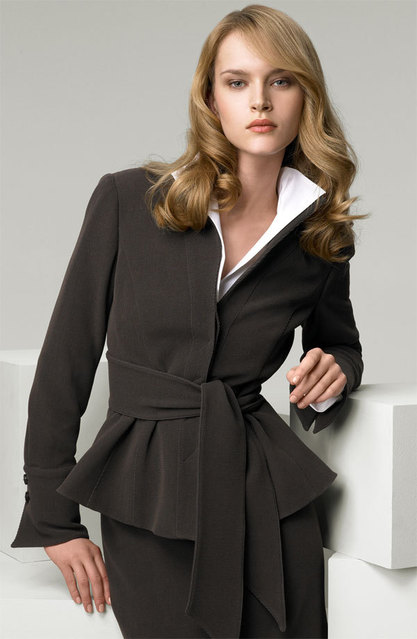 armani suit pic
armani suit pic armani suit wallpaper
armani suit wallpaper armani suit image
armani suit image armani suit
armani suit armani suit photo
armani suit photoItalian suits in the beginning of the last century were mainly of the bespoke variety, where a client could have a suit made exactly to his measurements and requirements. Each suit was custom-tailored for him by a single tailor from the beginning to the end and required a number of fittings. This practice continues to this day, and some of the most expensive suits in the world are painstakingly hand made by an increasingly scarce breed of extremely skilled tailors. These tailors know how to make suits that hide physical flaws and highlight attributes, without sacrificing comfort.
Machine use is minimal, and each and every nuance of a client's spoken and unspoken needs are met and often exceeded. Brioni, Attolini, Kiton, Luigi Borelli and Caraceni are some of the best known names in Italian bespoke suits. Some of the world's most expensive suits are the Kiton K50s exclusively tailored by Senor D'Orsi, one of the finest tailors in the world. He makes not more than 50 suits in a year, each costing up to 50,000 USD.
The fabrics used on a bespoke suit are usually the best, mostly worsted wool for business suits. These fabrics are used in the counts of 80's and 90's, or super 100's, super 150's and higher. The counts in the range of 80's and 90's also feel great and usually last longer than higher counts made at even the best clothing manufacturers.
The highest count worsted wools are usually very, very expensive, also because only the finest Merino yarns go into their making. These numbers define the number of yarns used per square inch of cloth, and the higher the count, the finer the fabric. The feel and the even the color and possible designs improve with the count, so a super 100's or higher is one of the best suiting fabrics.
Ermenegildo Zegna, Carlo Barbera, Loro Piana, Marzotto and Cerruti are some of the most renowned fabric manufacturers in Italy. For those who can afford it, a bespoke suit made in the super 150's fabric can be an absolute asset. It feels fabulously comfortable to wear and looks even better.
The Italian Made-to-measure Men's Suits
Not every one is privileged enough to get a bespoke suit made, but there is a range of suits which is nearly as good. With made-to-measure suits, it is possible to achieve a degree of customization because the tailor takes up to 25 measurements of an individual body, and these are then sent to the factory. Here, alterations are made to already available basic patterns in order to achieve the best fit possible.
Special requests like extra pockets, specific fabrics and linings, and a certain design and style
can be accommodated. Some of the
best fabrics, threads and interlinings are used, which helps guarantee a quality suit. But the production is assembly line, and many tailors work on the suit at different stages of production, unlike the single tailor for the bespoke suit.
Though not the same as a bespoke, one can get a very good suit from the made-to-measure process, and prestigious Italian names like Zegna, Canali and Brioni and many others provide excellent options for those who want a good suit without paying an arm and a leg for it. But one certainly has to be careful in choosing the company from which to order the suit. A lot depends on the knowledge and competence of the tailor who takes the measurements and the diligence with which these measurements are interpreted in the factory.
Ermenegildo Zegna su Misura does some of the best fittings in the made-to-measure industry. A good deal of technology goes into the making of these suits and their fabrics. Some Zegna suits use fabrics like Micronsphere which has all the great qualities of a worsted but is also stain-resistant, or Cashco, which is a blend of cashmere and cotton, making it an all-weather fabric.
The Italian Off-the-peg Designer Men's Suits
Though these cost about half that of a good made-to-measure Italian suit, they are still worth the money. The first and foremost advantage is speed, no agonizing fittings and long waits for the suit to get ready, and if chosen carefully, an off-the-peg suit from Prada, Armani, Giafranco Ferre, Versace or Gucci fits quite well. The trick is to shop around for the right size, cut and look. What is more, off-the-peg suits are good for those who are looking for variations, for different types of fabrics and styles. An Armani summer
suit is unbeatable for casual elegance and comfort: an Armani man is
understated yet dapper. His suit is a kind of professional armor, tailored yet draped, an effect which many of the Italian sartorial powerhouses may not achieve.
The beauty of an off-the-peg designer suit lies in its ability to change from season to season, and to bring in a hint of casual flair to the conservative world of men's business clothing. For those in the media, advertising, or culture, an added dash of outspoken sensibilities has now become more a matter of requirement than taste, and off-the peg suits fit the bill. Being the most economic, these suits also allow an average buyer to look suitably elegant in business attire.
For an Italian, the worst insult is brutta figura, or cutting a bad figure. It is always the intention and effort of most Italians to dress up so as to cut a good figure or bella figura. It is this obsession that has given Italian menswear, especially the suits, a look of classical, timeless elegance. If you are wearing an Italian men's business suit, chances are you are well on the way to the top of the ladder, in case you are not there already.








